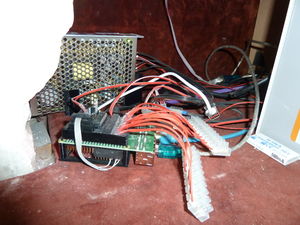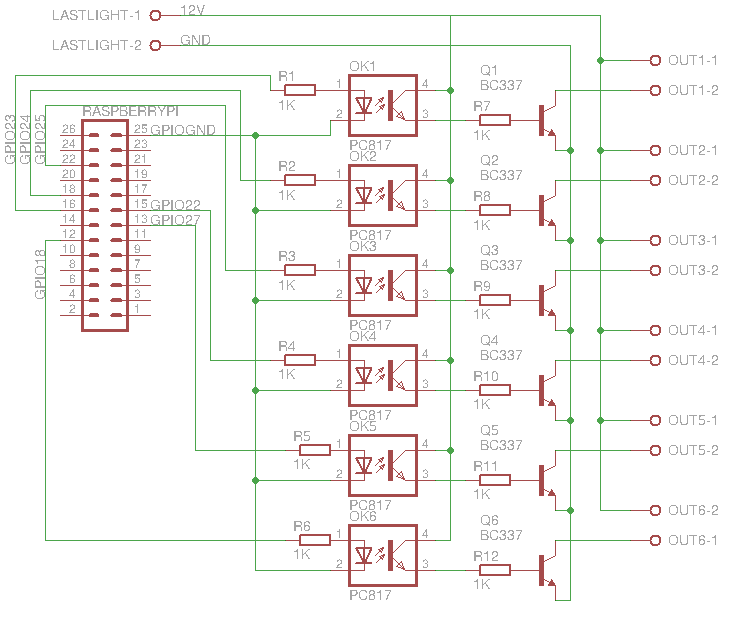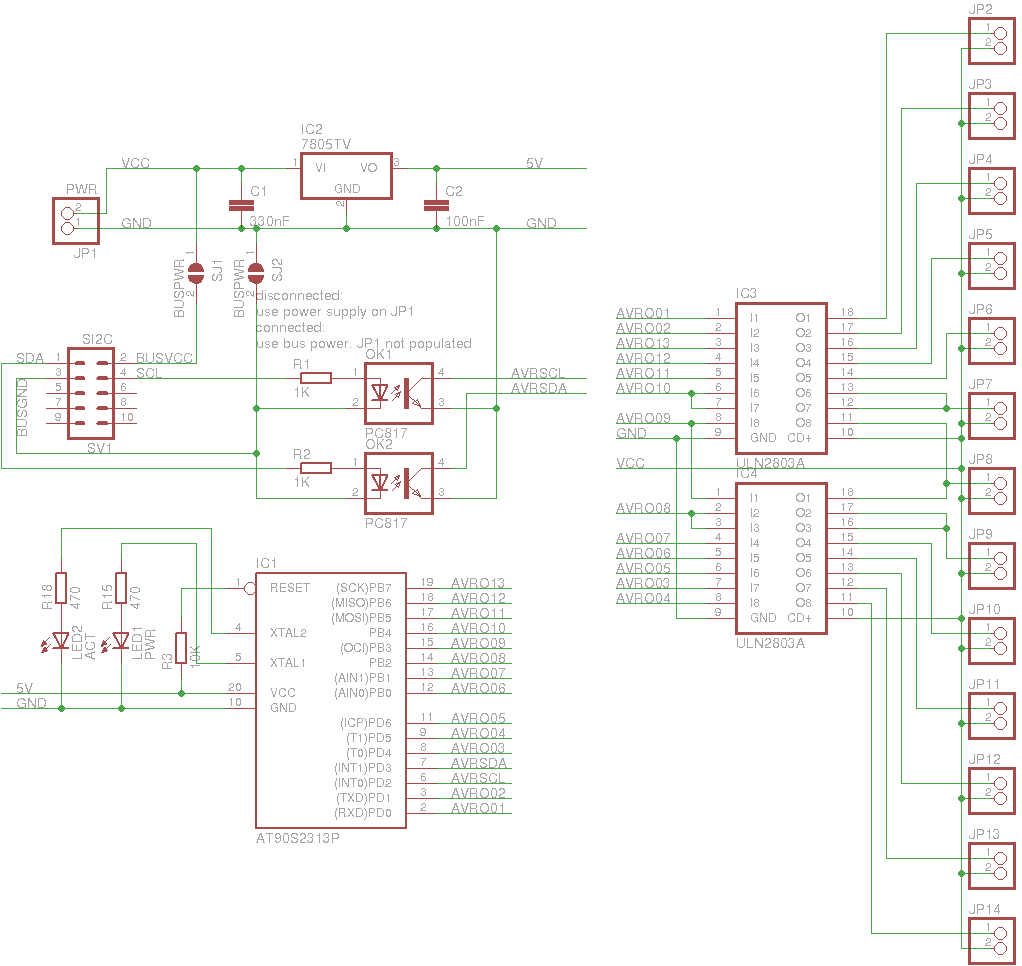(→Optokopplerboard: Stromversorgung) |
(Jetzt mit avrshift) |
||
| Line 65: | Line 65: | ||
|- | |- | ||
| P1:18 (GPIO24) || Optokopplerboard:2 | | P1:18 (GPIO24) || Optokopplerboard:2 | ||
|- | |||
| P1:20 (GND) || avrshift GPIOGND (2x RJ45 weiß) | |||
|- | |||
| P1:23 (GPIO11) || avrshift SDA | |||
|- | |||
| P1:24 (GPIO8) || avrshift SCL | |||
|- | |- | ||
| P1:25 (GND) || Optokopplerboard | | P1:25 (GND) || Optokopplerboard | ||
| Line 84: | Line 90: | ||
| 2 || Einzellitze rot/rot || LEDs im Schaufenster per 500mA-Schmelzsicherung und [http://www.farnell.com/datasheets/1581922.pdf OKI-78SR-5/1.5-W36-C] 5V 1.5A Schaltregler | | 2 || Einzellitze rot/rot || LEDs im Schaufenster per 500mA-Schmelzsicherung und [http://www.farnell.com/datasheets/1581922.pdf OKI-78SR-5/1.5-W36-C] 5V 1.5A Schaltregler | ||
|- | |- | ||
| 3 || RJ45 blau/weiß || Weiße LED- | | 3 || || | ||
|- | |||
| 4 || || | |||
|- | |||
| 5 || || | |||
|- | |||
| 6 || || | |||
|} | |||
== avrshift == | |||
[[File:Avrshift.png|300x300px|framed|right]] | |||
ATTiny2313 als Schieberegister mit twowire-Ansteuerung (An I²C angelehnt). Der oberste Anschluss (rotes Flachbandkabel) ist Nummer 1. | |||
Hängt an der Hackcenterdecke bei der blauen Neonröhre. Die RJ45-Adernpaare braun/weiß und gelb/weiß versorgen es mit +12V (bunt) bzw. GND (weiß). Über grün/weiß und blau/weiß kommen SDA, SCL, GND vom Raspberry Pi. | |||
{| class="wikitable" | |||
! Bit !! Gerät | |||
|- | |||
| 1 || | |||
|- | |||
| 2 || Blaue Neonröhre | |||
|- | |||
| 3 || Lampe im eMac über dem Drucker | |||
|- | |||
| 4 || Weiße LEDs über der Tischreihe | |||
|- | |||
| 5 || | |||
|- | |||
| 6 || Blauer LED-Streifen am Kabelkanal | |||
|- | |||
| 7 || | |||
|- | |||
| 8 || | |||
|- | |||
| 9 || | |||
|- | |||
| 10 || | |||
|- | |||
| 11 || | |||
|- | |||
| 12 || | |||
|- | |||
| 13 || | |||
|- | |||
|} | |||
Die Input-Pins akzeptieren Spannungen von 3 bis 16 Volt und sind durch Optokoppler galvanisch von der restlichen Schaltung getrennt. | |||
Kommunikation: | |||
{| class="wikitable" | |||
! SCL !! SDA !! Aktion | |||
|- | |- | ||
| | | ↑ || <tt>X</tt> || Bit <tt>X</tt> von rechts (als Least Significant Bit) ins Register schieben | ||
|- | |- | ||
| | | ↓ || 1 || Aktuelle Registerwerte auf Ausgänge übernehmen | ||
|- | |- | ||
| | | ↓ || 0 || ''Keine'' | ||
|} | |} | ||
Revision as of 17:59, 22 March 2013
| feedback.chaosdorf.dn42 | |
|---|---|

| |
| Raspberry Pi Model B Rev 2.0 | |
| Ort | Schleuse |
| Zweck | infodisplay, Türsteuerung |
| OS | Raspbian (Debian) Wheezy |
| Disks | 8GB SDHC"GBSDHC" is not declared as a valid unit of measurement for this property. |
| RAM | 512MB488.281 MiB <br />500,000 kiB <br />512,000,000 B <br />0.477 GiB <br />4.656613e-4 TiB <br /> |
| Swap | 100MB0.1 GB <br />100,000 kB <br />1.0e-4 TB <br /> |
| Admin-Toolkit | Yes |
| ssh key path | ~/.ssh/authorized_keys |
| PAM? | Yes |
| SSH user login? | No |
| Besitzstatus | Club-Eigentum |
| Kontakt | derf |
| Benutzung | Nachfragen |
| Admins | derf |
| MAC address | b8:27:eb:38:93:02 |
Steuert das Infodisplay und die Clubraumbeleuchtung. Zieht 4W0.004 kW <br />7.72 EUR/Year <br />.
/ ist read-only gemountet, die benutzten Dateisysteme (/srv/www, /tmp, /var/log) jeweils tmpfs.
Dienste
- dorfmap per hypnotoad (Mojolicious) und lighttpd mit mod_proxy. Wird beim Booten nach /srv/www gecloned. Siehe Lichtsteuerung
- Xorg mit nodm und dwm, siehe Infodisplay
- ring_bell per inetd für Türklingel und public/private announcements
Anschlüsse
| Anschluss | Gerät |
|---|---|
| USB | frei |
| USB | frei |
| HDMI | HDMI → DVI Kabel zum Infodisplay |
| microUSB (VCC) | +5V per TSR 1-2450 DC/DC 24V/5V 1A Schaltregler und Chaosdoor 12V-Netzteil |
| LAN | Direktverbindung zum Patchpanel im Serverraum |
| P1:2 (5V0) | Klingel |
| P1:3 (GPIO2) | Optokopplerboard:1 |
| P1:5 (GPIO3) | Optokopplerboard:5 |
| P1:7 (GPIO4) | Optokopplerboard:3 |
| P1:6 (GND) | Klingel |
| P1:9 (GND) | Außenbeleuchtung |
| P1:11 (GPIO17) | Einschaltsignal Außenbeleuchtung |
| P1:12 (GPIO18) | Signal für Klingel |
| P1:13 (GPIO27) | Optokopplerboard:6 |
| P1:15 (GPIO22) | Optokopplerboard:4 |
| P1:18 (GPIO24) | Optokopplerboard:2 |
| P1:20 (GND) | avrshift GPIOGND (2x RJ45 weiß) |
| P1:23 (GPIO11) | avrshift SDA |
| P1:24 (GPIO8) | avrshift SCL |
| P1:25 (GND) | Optokopplerboard |
Optokopplerboard
Die GPIO-Pins im Bild stimmen nicht, tatsächliche Inputs siehe oben. 12V-Versorgung kommt aus dem Chaosdoor-Netzteil.
Input n schaltet Output n.
| Anschluss | Kabel | Gerät |
|---|---|---|
| 1 | Doppellitze rot/weiß | LED-Leiste Chaosdorflogo innen |
| 2 | Einzellitze rot/rot | LEDs im Schaufenster per 500mA-Schmelzsicherung und OKI-78SR-5/1.5-W36-C 5V 1.5A Schaltregler |
| 3 | ||
| 4 | ||
| 5 | ||
| 6 |
avrshift
ATTiny2313 als Schieberegister mit twowire-Ansteuerung (An I²C angelehnt). Der oberste Anschluss (rotes Flachbandkabel) ist Nummer 1.
Hängt an der Hackcenterdecke bei der blauen Neonröhre. Die RJ45-Adernpaare braun/weiß und gelb/weiß versorgen es mit +12V (bunt) bzw. GND (weiß). Über grün/weiß und blau/weiß kommen SDA, SCL, GND vom Raspberry Pi.
| Bit | Gerät |
|---|---|
| 1 | |
| 2 | Blaue Neonröhre |
| 3 | Lampe im eMac über dem Drucker |
| 4 | Weiße LEDs über der Tischreihe |
| 5 | |
| 6 | Blauer LED-Streifen am Kabelkanal |
| 7 | |
| 8 | |
| 9 | |
| 10 | |
| 11 | |
| 12 | |
| 13 |
Die Input-Pins akzeptieren Spannungen von 3 bis 16 Volt und sind durch Optokoppler galvanisch von der restlichen Schaltung getrennt. Kommunikation:
| SCL | SDA | Aktion |
|---|---|---|
| ↑ | X | Bit X von rechts (als Least Significant Bit) ins Register schieben |
| ↓ | 1 | Aktuelle Registerwerte auf Ausgänge übernehmen |
| ↓ | 0 | Keine |

